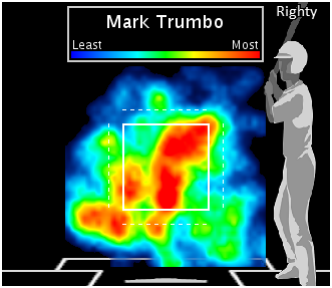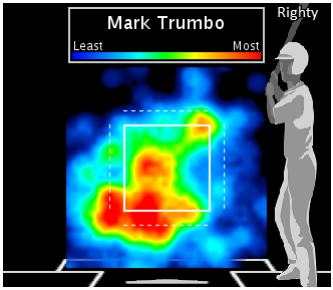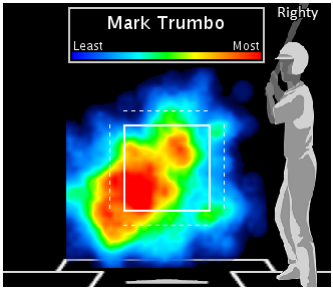Trumbo's Outer-Half Troubles Limit Power Potential With Diamondbacks
 Alec Dopp |
Alec Dopp |  Wednesday, December 18, 2013 at 11:43AM
Wednesday, December 18, 2013 at 11:43AM
Last Tuesday, the Diamondbacks gave up pitching prospect phenom Tyler Skaggs and Adam Eaton in a three-team trade involving the Angels and White Sox in return for corner outfield bat Mark Trumbo. A .234/.294/.453 hitter over 159 games last season with Los Angeles, the now 27-year-old Trumbo was believed to be high on the Diamondbacks' offseason radar this winter, as they were reportedly looking to add another power-type bat to complement first baseman Paul Goldschmidt.
Data from ESPN's hittrackeronline.com"I think he has the chance to hit 40 home runs in our park,"Diamondbacks general manager Kevin Towers told MLB.com's Steve Gilbert following the trade last week. "He should put up better numbers than he did in Anaheim based on park factors and how the park plays."
While I will agree that Trumbo certainly has enough power to rack up at least 40 home runs per season -- he's averaged 31 per season since 2011 -- even in a clearly lengthier ballpark in Arizona compared to Los Angeles, there is one significant flaw to his game that could prevent him from attaining such lofty home run totals. And that flaw happens to be is his struggle with the outside half of the strike zone.
Inner-half reliance
Before we delve into Trumbo's outer-half struggles, it's important to get some background on him as a hitter. As I'm sure many Angels fans can attest, Trumbo relies heavily on his ability to mash inner-half pitches while largely ignoring back-door stuff. Turns out they're right. Over 1853 career plate appearances, the former 18th-round pick out of high school in 2004 owns a career inner-half slash line of .274/.303/.580 despite a relatively low .275 BABIP mark. On the opposite half of the dish, however, Trumbo holds true to a .227/.294/.369 line in spite of his more typical .295 BABIP.
While Trumbo's inner and outer half on base percentage marks are essentially equal thus far, we see his outer-half batting average and slugging percentage are significantly lower. These statistical disparities can be attributed to plate discipline issues on outer-half offerings, against which Trumbo maintains a career strikeout rate of 27.5% compared to his 22.3% rate on inner-half pitches. The primary reason behind his elevated outer-half strikeout rate, as we're about to find out, stems from a progressive decline in his ability to place contact on such offerings.
Trumbo's swing-and-miss frequency, 2011
 Trumbo's swing-and-miss frequency, 2012
Trumbo's swing-and-miss frequency, 2012

Trumbo's swing-and-miss frequency, 2013

As we can see from the frequency maps above, Trumbo's swing-and-miss tendencies are progressively shifting to the outer half of the plate since his first full season with the Angels in 2011. Three seasons ago, Trumbo didn't seem to have a specific area of the strike zone in which most of his "whiffs" were located. Of the 287 pitches that induced a swing-and-miss, 137 (47.7%) were located on the outer-half, while 150 (52.3%) fell on the inner-half of the plate. For the season, Trumbo posted a 25.4% swing-and-miss rate, which was above the 20.3% league average for right-handed batters that year.
Trumbo's swing-and-miss rate increased to 31.1% in 2012 (fourth-worst among qualified right-handed batters), nearly six percentage points higher than the previous season and more than 10 points higher than the 20.5% league mark for righties. What's most intriguing about this increase, however, is that the vast majority of his swings and misses occured on the outer-half of the plate. Of his 347 whiffs in 2012, 211 (60.8%) transpired on outer-half pitches comapred to the 136 (39.2%) that were located on the inner half.
As you may have guessed from the images above, Trumbo's 2013 miss frequency only increased as his tendency to come up empty on outer-half offerings surged further. Last season, Trumbo's miss rate grew to a career-worst 31.8% (juxtaposed to the 20.8% league average), which was sixth-highest among qualified right-handed batters. And again, the bulk of his 398 total whiffs were on the outer-half (64.1%) apposed to the inner-half (35.9%).
What does this mean for Trumbo moving forward? As pitchers recognize where the majority of his swings and misses occur most frequently -- the outer half of the plate, as we've just discovered -- they will continue to pound that area of the zone. The onus will fall on Trumbo to make adjustments and not be as reliant on the inner half, as he has been for his entire career. If he does, then there's no reason to believe he won't reach the 40 home run plateau his new GM believes he can.

Reader Comments